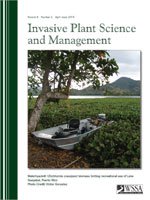Grazing represents a sustainable alternative for the control of medusahead infestations but intake of medusahead by ruminants is typically low. We determined in sheep whether (1) high-energy supplements enhance medusahead intake and preference relative to a treatment without supplementation and (2) individual differences in medusahead intake transfer to individual differences in the ingestion of a silica-containing ration. Groups of lambs (n = 10) were individually penned and randomly assigned to three supplementation treatments: (1) Control (no supplement); (2) Calcium (Ca) Propionate (beet pulp : barley : Ca propionate, 67 : 30 : 3); or (3) Yeast (beet pulp : barley : yeast culture, 65 : 30 : 5). After supplementation, all animals had ad libitum access to medusahead in late vegetative to mid-reproductive (Trial 1), and late-reproductive phenological stages (Trial 2). Medusahead preferences were assessed by offering sheep a choice between medusahead and tall fescue hay. Plant part preferences were assessed by offering a choice between medusahead tops (mostly seedheads and awns) and mid-plant parts (mostly stems leaves). Intake of medusahead was low and cyclic, declining towards the end of each trial (P < 0.0001) and there were no treatment differences (P > 0.10). Lambs preferred tall fescue hay to medusahead and medusahead tops to mid-plant parts (P < 0.0001). Supplemented lambs gained more weight than control lambs (P < 0.10). Thus, supplemented lambs performed better than nonsupplemented controls without reducing their intake of medusahead. In Trial 3, two new groups of lambs were formed based on their intake of medusahead during Trials 1 and 2 (n = 10). One group consistently ate more medusahead and more of a ration containing silica (alfalfa : silica, 97 : 3) than the other (P < 0.10). A significant and consistent degree of individual variation was measured among lambs—irrespective of treatment—regarding their ability to ingest medusahead and silica. This variation represents a promising option for maximizing use of medusahead by livestock in rangelands.
Nomenclature: Medusahead, Taeniatherum caput-medusae (L.) Nevski.
Management Implications: High-energy supplements containing glucogenic agents (Ca propionate) or yeast cultures (S. cerevisiae fermentation products) did not increase medusahead use by lambs relative to unsupplemented animals. However, our results suggest that supplementation programs can improve the production of grazing animals in targeted grazing treatments without depressing the ingestion of medusahead relative to unsupplemented (i.e., forced to ingest medusahead) animals. Intake of medusahead was low and cyclic suggesting a metabolic constraint which restricts the amount of forage consumed by an animal on a daily basis. However, a significant degree of individual variation was measured in the animals under study—irrespective of treatment—suggesting that these differences were more relevant than the treatments used to enhance intake of the weed. Individual differences in medusahead intake by livestock represents a promising option for maximizing use of medusahead by livestock on rangelands.





